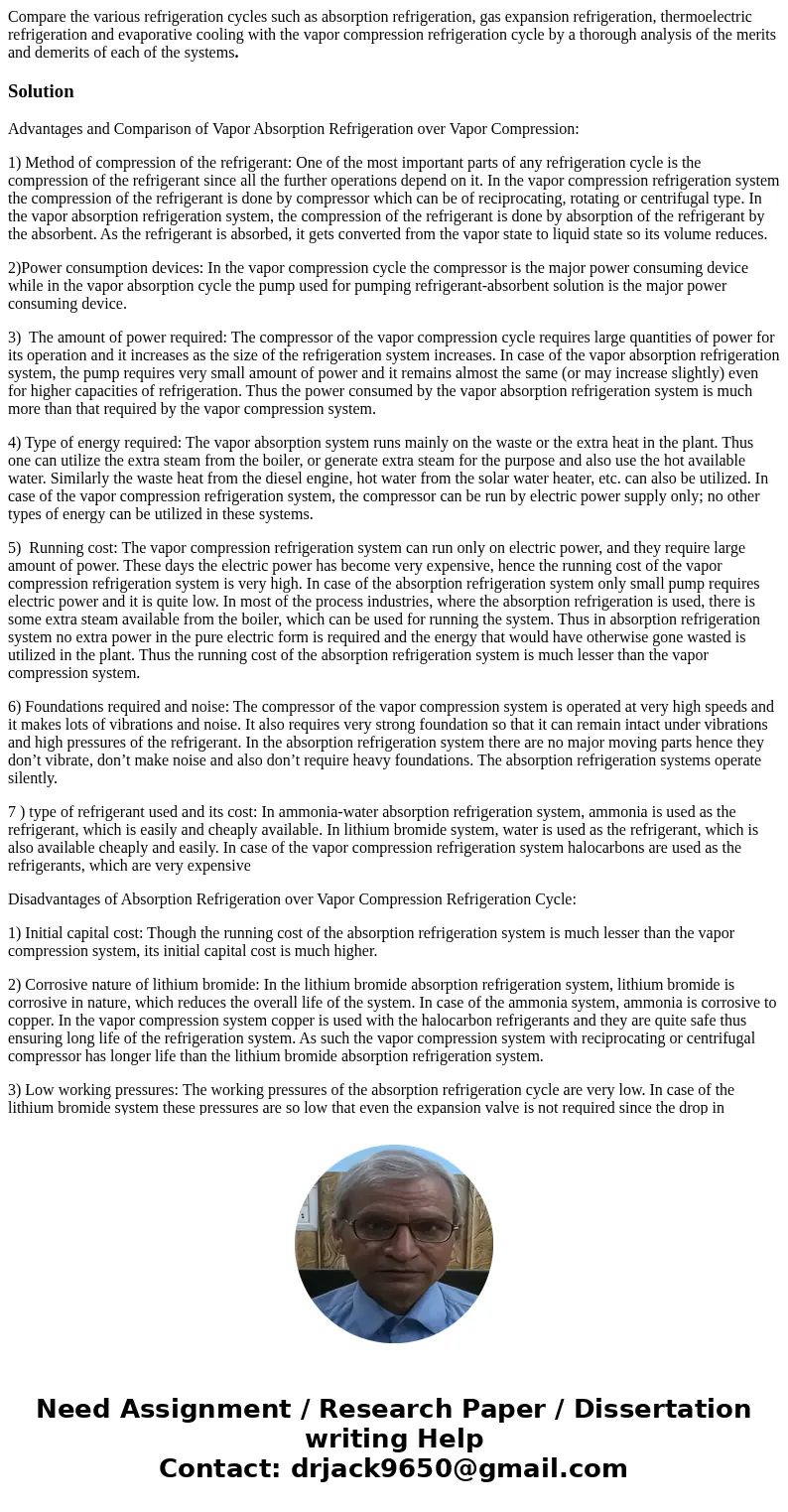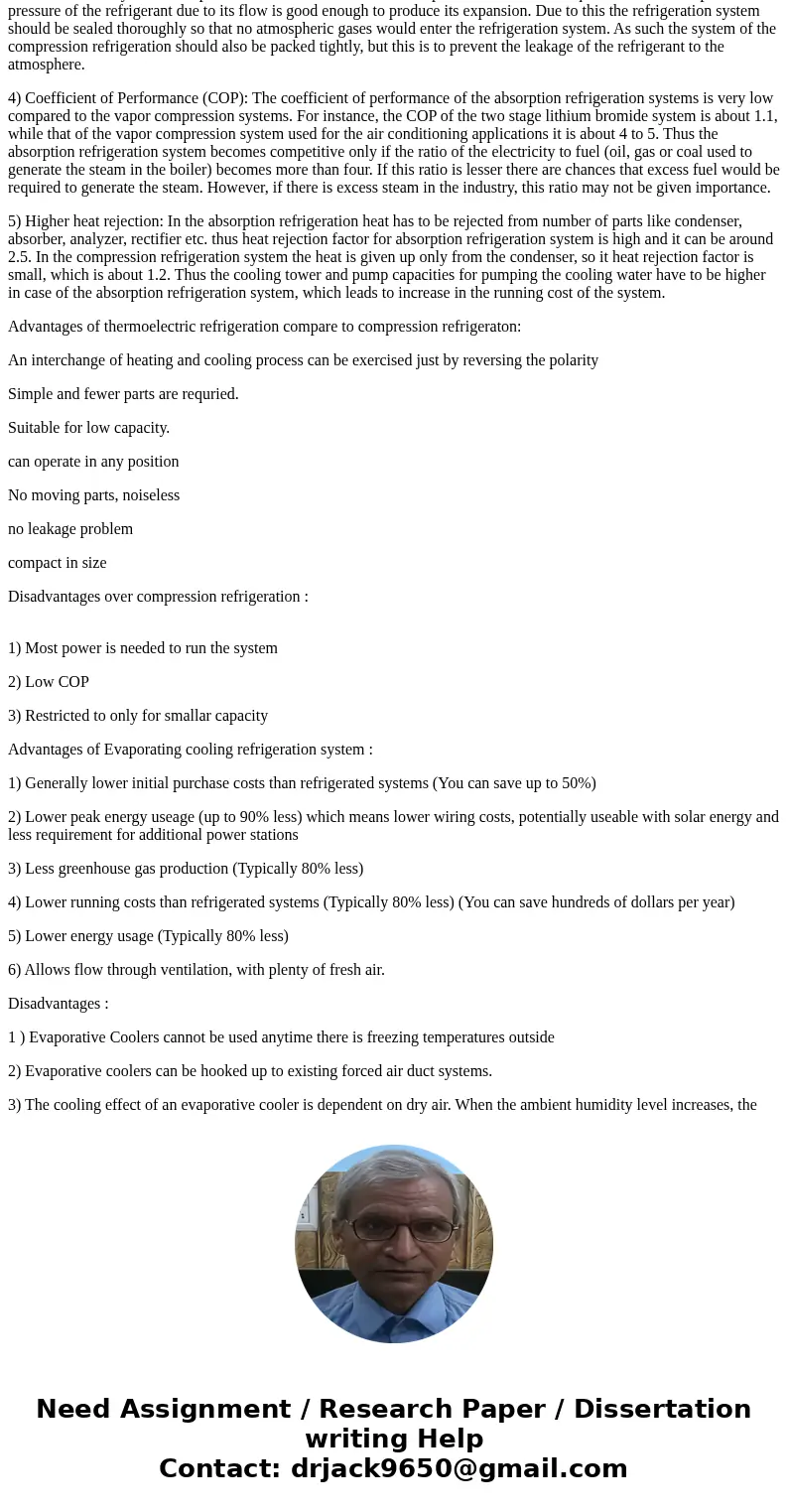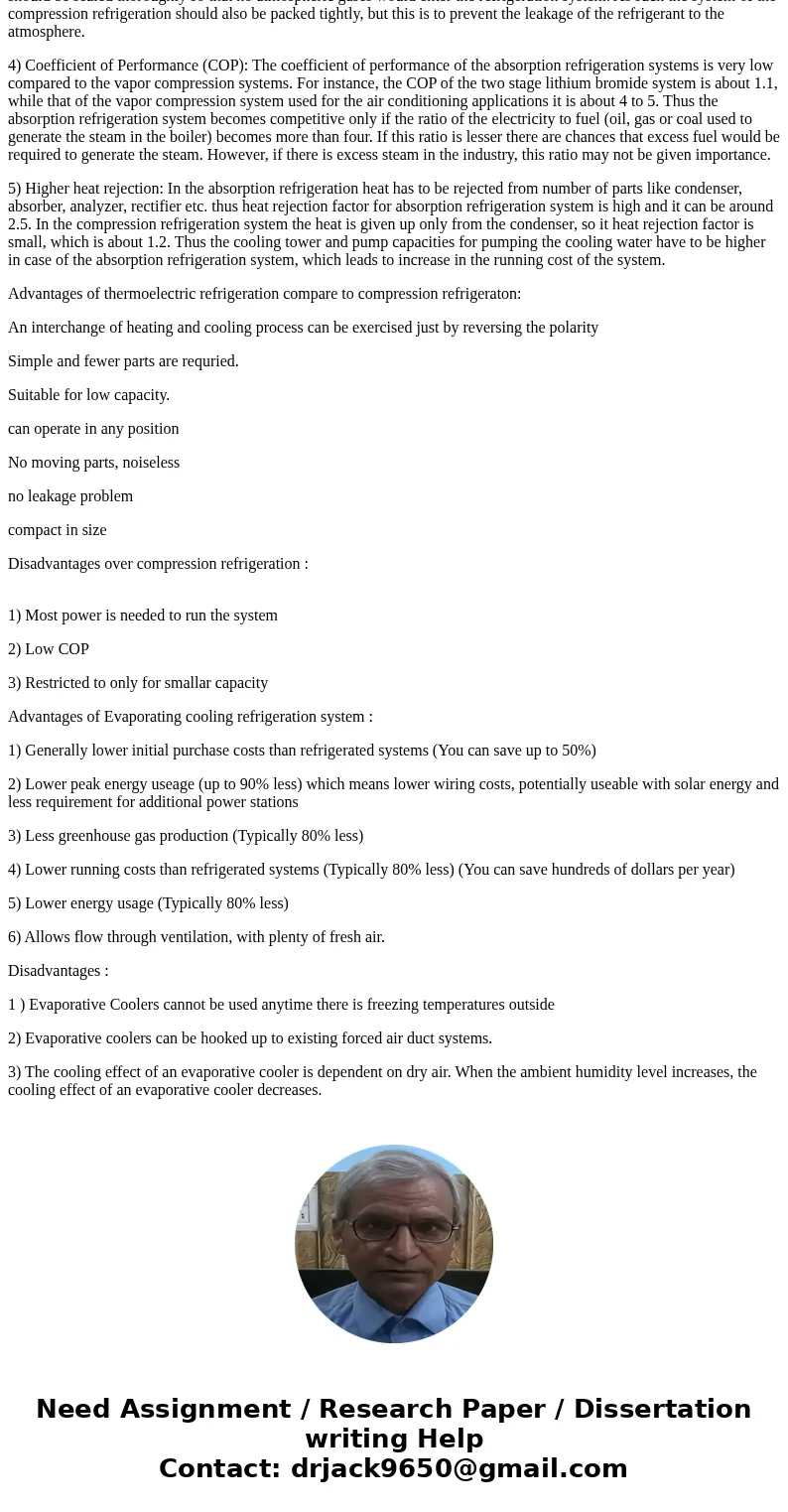Compare the various refrigeration cycles such as absorption
Compare the various refrigeration cycles such as absorption refrigeration, gas expansion refrigeration, thermoelectric refrigeration and evaporative cooling with the vapor compression refrigeration cycle by a thorough analysis of the merits and demerits of each of the systems.
Solution
Advantages and Comparison of Vapor Absorption Refrigeration over Vapor Compression:
1) Method of compression of the refrigerant: One of the most important parts of any refrigeration cycle is the compression of the refrigerant since all the further operations depend on it. In the vapor compression refrigeration system the compression of the refrigerant is done by compressor which can be of reciprocating, rotating or centrifugal type. In the vapor absorption refrigeration system, the compression of the refrigerant is done by absorption of the refrigerant by the absorbent. As the refrigerant is absorbed, it gets converted from the vapor state to liquid state so its volume reduces.
2)Power consumption devices: In the vapor compression cycle the compressor is the major power consuming device while in the vapor absorption cycle the pump used for pumping refrigerant-absorbent solution is the major power consuming device.
3) The amount of power required: The compressor of the vapor compression cycle requires large quantities of power for its operation and it increases as the size of the refrigeration system increases. In case of the vapor absorption refrigeration system, the pump requires very small amount of power and it remains almost the same (or may increase slightly) even for higher capacities of refrigeration. Thus the power consumed by the vapor absorption refrigeration system is much more than that required by the vapor compression system.
4) Type of energy required: The vapor absorption system runs mainly on the waste or the extra heat in the plant. Thus one can utilize the extra steam from the boiler, or generate extra steam for the purpose and also use the hot available water. Similarly the waste heat from the diesel engine, hot water from the solar water heater, etc. can also be utilized. In case of the vapor compression refrigeration system, the compressor can be run by electric power supply only; no other types of energy can be utilized in these systems.
5) Running cost: The vapor compression refrigeration system can run only on electric power, and they require large amount of power. These days the electric power has become very expensive, hence the running cost of the vapor compression refrigeration system is very high. In case of the absorption refrigeration system only small pump requires electric power and it is quite low. In most of the process industries, where the absorption refrigeration is used, there is some extra steam available from the boiler, which can be used for running the system. Thus in absorption refrigeration system no extra power in the pure electric form is required and the energy that would have otherwise gone wasted is utilized in the plant. Thus the running cost of the absorption refrigeration system is much lesser than the vapor compression system.
6) Foundations required and noise: The compressor of the vapor compression system is operated at very high speeds and it makes lots of vibrations and noise. It also requires very strong foundation so that it can remain intact under vibrations and high pressures of the refrigerant. In the absorption refrigeration system there are no major moving parts hence they don’t vibrate, don’t make noise and also don’t require heavy foundations. The absorption refrigeration systems operate silently.
7 ) type of refrigerant used and its cost: In ammonia-water absorption refrigeration system, ammonia is used as the refrigerant, which is easily and cheaply available. In lithium bromide system, water is used as the refrigerant, which is also available cheaply and easily. In case of the vapor compression refrigeration system halocarbons are used as the refrigerants, which are very expensive
Disadvantages of Absorption Refrigeration over Vapor Compression Refrigeration Cycle:
1) Initial capital cost: Though the running cost of the absorption refrigeration system is much lesser than the vapor compression system, its initial capital cost is much higher.
2) Corrosive nature of lithium bromide: In the lithium bromide absorption refrigeration system, lithium bromide is corrosive in nature, which reduces the overall life of the system. In case of the ammonia system, ammonia is corrosive to copper. In the vapor compression system copper is used with the halocarbon refrigerants and they are quite safe thus ensuring long life of the refrigeration system. As such the vapor compression system with reciprocating or centrifugal compressor has longer life than the lithium bromide absorption refrigeration system.
3) Low working pressures: The working pressures of the absorption refrigeration cycle are very low. In case of the lithium bromide system these pressures are so low that even the expansion valve is not required since the drop in pressure of the refrigerant due to its flow is good enough to produce its expansion. Due to this the refrigeration system should be sealed thoroughly so that no atmospheric gases would enter the refrigeration system. As such the system of the compression refrigeration should also be packed tightly, but this is to prevent the leakage of the refrigerant to the atmosphere.
4) Coefficient of Performance (COP): The coefficient of performance of the absorption refrigeration systems is very low compared to the vapor compression systems. For instance, the COP of the two stage lithium bromide system is about 1.1, while that of the vapor compression system used for the air conditioning applications it is about 4 to 5. Thus the absorption refrigeration system becomes competitive only if the ratio of the electricity to fuel (oil, gas or coal used to generate the steam in the boiler) becomes more than four. If this ratio is lesser there are chances that excess fuel would be required to generate the steam. However, if there is excess steam in the industry, this ratio may not be given importance.
5) Higher heat rejection: In the absorption refrigeration heat has to be rejected from number of parts like condenser, absorber, analyzer, rectifier etc. thus heat rejection factor for absorption refrigeration system is high and it can be around 2.5. In the compression refrigeration system the heat is given up only from the condenser, so it heat rejection factor is small, which is about 1.2. Thus the cooling tower and pump capacities for pumping the cooling water have to be higher in case of the absorption refrigeration system, which leads to increase in the running cost of the system.
Advantages of thermoelectric refrigeration compare to compression refrigeraton:
An interchange of heating and cooling process can be exercised just by reversing the polarity
Simple and fewer parts are requried.
Suitable for low capacity.
can operate in any position
No moving parts, noiseless
no leakage problem
compact in size
Disadvantages over compression refrigeration :
1) Most power is needed to run the system
2) Low COP
3) Restricted to only for smallar capacity
Advantages of Evaporating cooling refrigeration system :
1) Generally lower initial purchase costs than refrigerated systems (You can save up to 50%)
2) Lower peak energy useage (up to 90% less) which means lower wiring costs, potentially useable with solar energy and less requirement for additional power stations
3) Less greenhouse gas production (Typically 80% less)
4) Lower running costs than refrigerated systems (Typically 80% less) (You can save hundreds of dollars per year)
5) Lower energy usage (Typically 80% less)
6) Allows flow through ventilation, with plenty of fresh air.
Disadvantages :
1 ) Evaporative Coolers cannot be used anytime there is freezing temperatures outside
2) Evaporative coolers can be hooked up to existing forced air duct systems.
3) The cooling effect of an evaporative cooler is dependent on dry air. When the ambient humidity level increases, the cooling effect of an evaporative cooler decreases.



 Homework Sourse
Homework Sourse